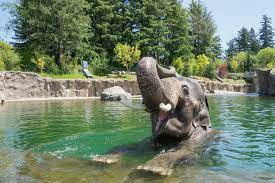Oregon Zoo
The Oregon Zoo, formerly known as the Portland Zoo and later as the Washington Park Zoo, is a zoo in Washington Park, Portland, Oregon, about 2 miles (3.2 km) southwest of downtown Portland. It is the oldest zoo west of the Mississippi River, having opened in 1888. The Metro government owns the 64-acre (26-hectare) zoo. It currently houses over 1,800 animals from over 230 different species, including 19 endangered and 9 threatened species. The zoo also has a large plant collection that is displayed in its animal exhibits and specialized gardens. The zoo also operates and maintains the 2 ft 6 in (762 mm) narrow gauge Washington Park & Zoo Railway, which previously connected to the park's International Rose Test Garden but now runs outside. However, it is currently only available within the zoo.With over 1.6 million visitors in 2016, the Oregon Zoo is the state's largest paid and arguably most popular visitor attraction. The zoo belongs to the Association of Zoos and Aquariums as well as the World Association of Zoos and Aquariums.
History
The Oregon Zoo was established in 1888, making it the oldest zoo west of the Mississippi.
Richard Knight started it all with two bears, one brown and one grizzly. Knight, a former sailor turned pharmacist, began collecting animals from his seafaring friends. His collection was kept in the back of his drug store on Third and Morrison streets. When caring for the animals became too much of a burden, he attempted to sell them to the city of Portland. Instead of purchasing the animals, the city offered Knight two circus cages and permission to keep the caged bears on the grounds of City Park (now called Washington Park). The Knight family and friends were still in charge of the bears' care and feeding. It wasn't long before Knight spoke to the city council again about the bears. Only five months later, he offered to give the bears and their cages to the city. On November 7, 1888, Portland City Council accepted his offer, and the Portland Zoo was born. It was known as the Washington Park Zoo because it was located in Washington Park.
In April 1998, the Metro Council renamed the zoo from the Washington Park Zoo to the .Oregon Zoo. The zoo became accessible by the region's MAX light rail system in September of that year, with the opening of a West side MAX line with an underground Washington Park station. The zoo began participating in a California condor recovery programme initiated by the San Diego Wild Animal Park and the Los Angeles Zoo in 2003. The programme aims to breed California condors for release into the wild, thereby saving them from extinction. Regional voters approved a $125 million bond measure in November 2008 to improve infrastructure, improve older exhibits, and increase access to conservation education and the degree of sustainability. The zoo's attendance has reached an all-time high.
For the 2008–2009 fiscal year, the zoo attracted a record 1.6 million visitors.Part of the reason for the record was the birth of another baby elephant. The following year, 1,612,359 people visited the zoo, setting a new record. In 2016, the zoo welcomed over 1.6 million visitors. Packy was euthanized on February 9, 2017 by Oregon Zoo staff after a long battle with drug-resistant tuberculosis. He was buried in a city-owned "wooded, grassy area" that is not open to the public. Packy was 54 years old at the time of his death.
Hello and welcome to the Oregon Zoo!
The Oregon Zoo is open daily from 9:30 a.m. to 5:00 p.m., with the last reservation being at 3:30 p.m. Masks are no longer necessary. Every day and hour is subject to change. We have temporarily moved some birds out of sight to help protect them from avian influenza.
What a ride! Take a trip down memory lane on the historic Washington Park and Zoo Railway. This six-minute ride circles a 20-foot-high elevated trestle in the forest north of Elephant Lands, following the same route the train took when it first opened in 1958. The train operates from 10:30 a.m. to 5 p.m. Every 15 to 20 minutes, passengers board.






.jpg)
No comments:
Post a Comment